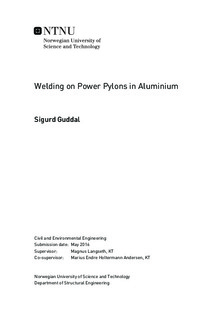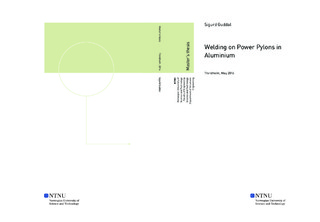| dc.contributor.advisor | Langseth, Magnus | |
| dc.contributor.advisor | Holtermann Andersen, Marius Endre | |
| dc.contributor.author | Guddal, Sigurd | |
| dc.date.accessioned | 2019-09-11T08:35:02Z | |
| dc.date.available | 2019-09-11T08:35:02Z | |
| dc.date.created | 2016-05-25 | |
| dc.date.issued | 2016 | |
| dc.identifier | ntnudaim:14802 | |
| dc.identifier.uri | http://hdl.handle.net/11250/2614911 | |
| dc.description.abstract | This master thesis has investigated the behaviour of aluminium cylinders subjected to compression for both unwelded and welded cross sections. Three different combinations of material and geometry has been tested in the laboratory, but also numerical analysis has been carried out by a numerical software, such as finite element programme. The aluminium alloys tested in this thesis are the heat treatable alloys 6060-T6 and 6082-T6.
Material tests, such as tensile tests have been performed to get accurate material models in the numerical study. These tensile tests were performed without significant problems, but a notable large scatter was found from alloy 6082-T6. Digital Image Correlation (DIC) was used to find the strain.
Only stub tests were performed in the laboratory due to unfinished design of the test rig to be used for long columns. The lengths performed were two and four times the diameter of the cylinders tested, and these tests were performed for both unwelded and welded cross sections. When welding was applied on the cylinders, only a surface weld was performed. The welds were welded symmetrical on two sides in the longitudinal axis at the mid-center of the cylinders with a length equal to the radius of the cylinders. Welded cross sections are of interest due to the significant lower material strength parameters in the vicinity of a weld. This area is called the heat affected zone (HAZ). The material parameters in the HAZ are found from previous studies, where hardness tests of the material were performed to find yield and ultimate tensile strength.
The results from laboratory stub tests showed that unwelded cross sections localised the deformation symmetrical near one of the ends, but the welded cross sections triggered the cylinders to buckle at the mid-sections.
Analytical formulas for both shells independent of length, and long columns have been derived. Formulas for shell subjected to axial compression have been compared with laboratory experiments with a good degree of accuracy.
Numerical analysis have been able to recreate the deformation modes excelent for both unwelded and welded cross sections. The critical buckling stress and force-displacement curve is very accurate for alloy 6060-T6 but numerical results is a little conservative for alloy 6082-T6. This may be due to the large scatter from tensile test of 6082-T6. For welded cross sections, the critical buckling stress found from numerical analysis fits actually slightly better the laboratory results than the unwelded cylinders.
Very much time is spent on measure accurate geometry of the cylinders and the welds on every cylinders tested by use of a ultrasound device and a classical caliper. There were not much deviation in the measured geometry, so the mean values were used in the numerical analysis.
The laboratory results were compared with calculations from Eurocode 9: Design of Aluminium structures for both unwelded and welded cross sections and the results shows that the cylinders tested can resist up to twice the load calculated by EC9, depending on whether f_o is taken from EC9 or the tensile test performed in this study. | en |
| dc.language | eng | |
| dc.publisher | NTNU | |
| dc.subject | Bygg- og miljøteknikk, Beregningsmekanikk | en |
| dc.title | Welding on Power Pylons in Aluminium | en |
| dc.type | Master thesis | en |
| dc.source.pagenumber | 143 | |
| dc.contributor.department | Norges teknisk-naturvitenskapelige universitet, Fakultet for ingeniørvitenskap,Institutt for konstruksjonsteknikk | nb_NO |

